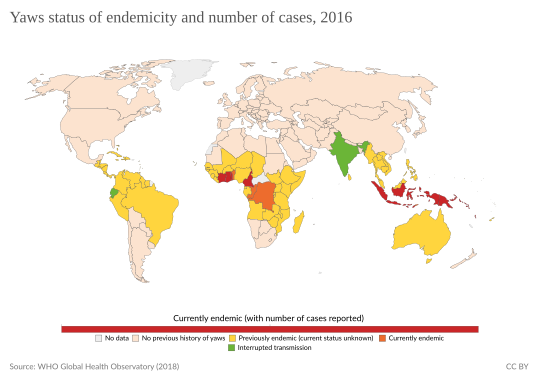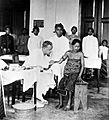Yaws facts for kids
Yaws is a tropical infection that mainly affects the skin, bones, and joints. It is caused by a tiny living thing called a bacterium. This bacterium is named Treponema pallidum pertenue.
The disease often starts with a round, firm bump on the skin. This bump can be about two to five centimeters wide. Sometimes, the middle of the bump can break open and form a sore. This first sore usually gets better on its own in about three to six months.
Later, sometimes weeks or even years after the first sore, new problems can appear. People might feel pain in their joints and bones. They might also feel very tired. New skin sores can show up. The skin on the palms of the hands and the soles of the feet might get thick and crack. In some cases, bones, especially in the nose, can change shape. After many years, large areas of skin can die, leaving big scars.
Yaws spreads when people touch the fluid from the sores of someone who has the disease. It is most common among children. They often spread it to each other while playing.
Contents
What Causes Yaws?
Yaws is spread through direct skin-to-skin contact with an infected person. The bacterium usually enters the body through a small cut, bite, or scratch on the skin.
A person can spread yaws for about 12 to 18 months after they get infected. If the disease comes back, they might be able to spread it for longer. Early yaws sores can be itchy. Sometimes, more sores appear along lines where the skin has been scratched.
Yaws is most often found in children. They tend to spread it easily when they play together. It is not believed that a mother can pass yaws to her baby during pregnancy.
Scientists have found the T. pallidum pertenue bacterium in animals like baboons, chimpanzees, and gorillas. When humans were given the bacterium from these animals in experiments, they developed a disease similar to yaws. However, there is no clear proof that humans and primates spread yaws to each other. More research is needed to be sure.
How Yaws Is Treated
Yaws can be treated with antibiotics. The most common treatment is a single shot of a long-lasting medicine called benzathine benzylpenicillin. Less often, other antibiotics like azithromycin or tetracycline tablets are used.
Penicillin has been the main treatment for yaws since the 1960s. So far, there is no strong evidence that the yaws bacterium has become resistant to penicillin. This means the medicine still works well.
Without treatment, about 10% of people with yaws can develop lasting physical changes or deformities.
Where Yaws Is Found

Where the road ends, yaws begins
The bacterium that causes yaws, T. pallidum pertenue, needs warm and humid conditions to survive. Because of this, yaws is found in humid tropical forest areas. These areas include parts of South America, Africa, Asia, and Oceania.
About three-quarters of the people who get yaws are children under 15 years old. The most cases are seen in children aged 6 to 10 years. This means children are the main group that carries and spreads the infection.
Yaws is more common in remote areas where it is harder to get medical treatment. It is also linked to poverty and places with poor sanitation and personal hygiene.
Globally, almost 85% of yaws cases are found in Ghana, Papua New Guinea, and the Solomon Islands. While rates in sub-Saharan Africa are generally low, they can be high in specific communities. As of 2015, it was thought that about 89 million people lived in areas where yaws is common. However, the information is not always complete, so this number might be too high.
In the early 1900s, yaws was very common. In parts of sub-Saharan Africa, it was treated more often than malaria. Sometimes, it made up more than half of all medical treatments.
In the 1950s, large campaigns to treat yaws greatly reduced the number of cases worldwide. The number dropped from 50 to 150 million cases to fewer than 2.5 million. However, during the 1970s, there were new outbreaks in South-East Asia. There have also been occasional cases in South America. As of 2011, it was not clear how many people around the world were currently infected.
From 2008 to 2012, 13 countries reported over 300,000 new cases to the World Health Organization (WHO). There was no system to confirm if yaws had been completely removed from a local area. It is also not known if some countries stopped reporting cases because they no longer had yaws, or if they just stopped collecting the information.
Generally, yaws is not a disease that doctors are required to report to health authorities.
History of Yaws
Signs of yaws have been found in the remains of Homo erectus from Kenya. These remains are about 1.6 million years old. This suggests that yaws has been around for a very long time.
Genetic studies of the yaws bacterium, Treponema pallidum pertenue, suggest it is the oldest of the four known Treponema diseases. It is thought that all other types of Treponema pallidum bacteria developed from Treponema pallidum pertenue.
Yaws is believed to have started in tropical parts of Africa. It then spread to other tropical areas of the world through people moving and through the slave trade. The slave trade likely brought yaws to Europe from Africa in the 15th century. The first clear description of yaws was written by the Dutch doctor Willem Piso.
The English name "yaws" is thought to come from the Carib word "yaya," which means "sore."
Towards the end of the Second World War, yaws became very common in northern Malaya while it was under Japanese control. After the country was freed, people were treated for yaws with injections of arsenic. However, there was not enough arsenic, so only those with the first stage of the disease could be treated.
Images for kids
See also
 In Spanish: Pian (enfermedad) para niños
In Spanish: Pian (enfermedad) para niños


